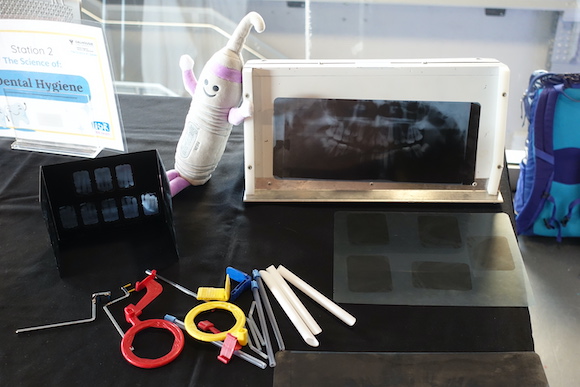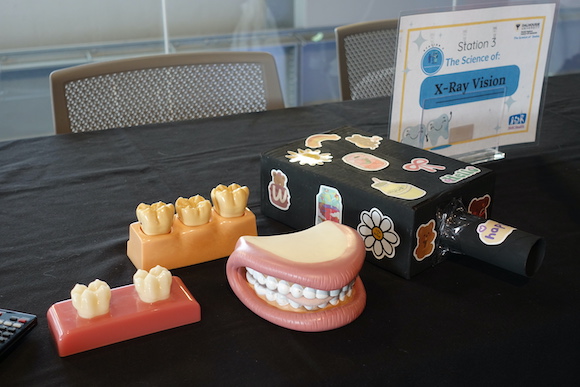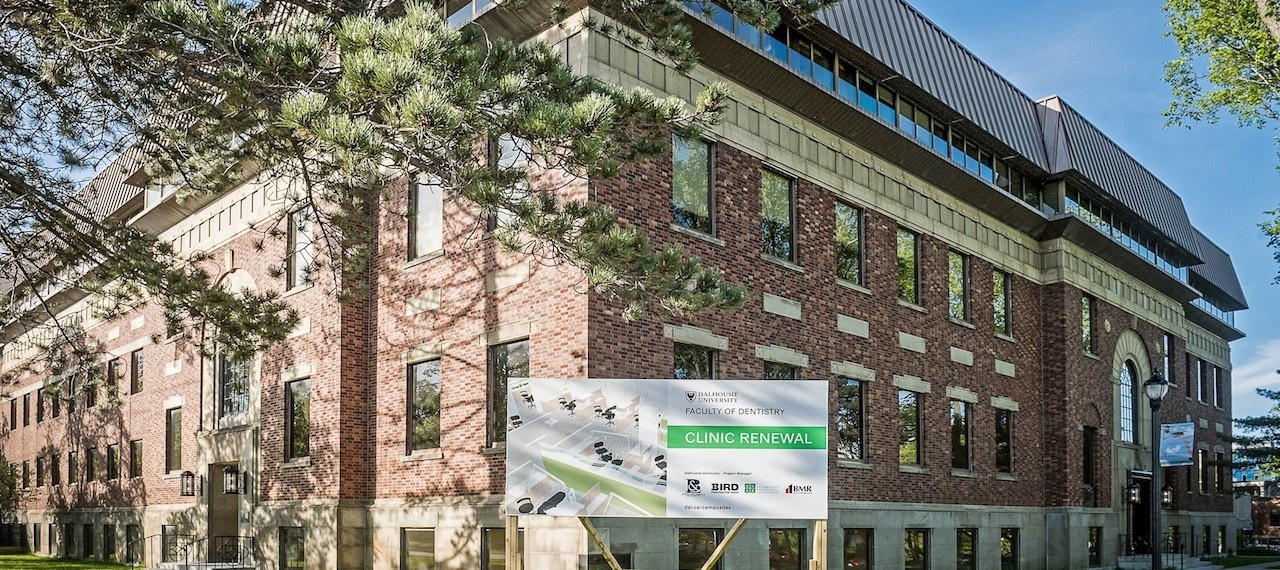News
» Go to news mainLearning about good dental hygiene at The Science of Smiles 2025
 What do you get when you bring together some keen dental hygiene students, a mock x-ray machine, hands-on experiments, a large tooth costume, and hundreds of children to celebrate Oral Health Month and National Dental Hygienists Week? Why, an outrageously fun – and educational – Science of Smiles Day at the Discovery Centre, of course!
What do you get when you bring together some keen dental hygiene students, a mock x-ray machine, hands-on experiments, a large tooth costume, and hundreds of children to celebrate Oral Health Month and National Dental Hygienists Week? Why, an outrageously fun – and educational – Science of Smiles Day at the Discovery Centre, of course!
The idea for Science of Smiles Day, which was held on April 5, 2025, took shape in Prof. Shauna Hachey’s population health class in January. This course is aimed at getting students out into the community to promote good oral health care. Students typically visit schools, long-term care homes, and newcomer and cancer care centres.
This year, however, Hachey successfully pitched to the class the idea of doing one big event at the Discovery Centre in Halifax. "I felt like it was a moment in time when it was important to promote evidence-based information, particularly around fluoride," explains Hachey.
The class then met every week to discuss ideas and decided to build on what the Discovery Centre is known for, which is science. That was how "The Science of Smiles" was born.
Five stations and a passport
Five different stations were created throughout the Discovery Centre plus a welcome booth near the entrance, where children picked up event passports. These were used to collect stickers or stamps when an activity was completed at any of the stations. When the passports were full, children could return to the welcome booth and collect dental hygiene kit. Information about public health insurance plans, radiation safety, and fluoride, was also available at the welcome booth.
 Station 1 – The science of dental hygiene
Station 1 – The science of dental hygiene
At this station, children were able to put on Dalhousie clinic jackets and safety glasses and pretend to be dental hygienists. A portable dental light and chair with a dentiform velcroed to the seat enabled children to practise their brushing and flossing. It was a "huge hit", says Hachey.
 Station 2 – The science of x-ray vision
Station 2 – The science of x-ray vision
Radiation safety was the focus of this station. Students made a mock x-ray unit that the children could use to take ”x-rays” of imitation teeth that they could touch and feel and then look at examples on the x-ray viewer afterwards.
Station 3 – The science of food
A game aimed at building healthy plates using different food items was one of the activities at this station. "We didn’t just want to talk about sugar at this booth," says Hachey. "We wanted to talk about the key principles of food that we know are important, like consistency, frequency, and whether it’s with or between meals."
Another game was about taking an amount of sugar and matching it to a food, so that visitors could see the amount of sugar in a can of pop versus the amount in an apple, for example.
 Station 4 – The science of prevention
Station 4 – The science of prevention
This station featured mouthguards, models of sealants, toothbrushes, fluoride products, interdental aids, and posters with oral health care information. The dental hygiene students created a felt board that featured pink gums and red gums to explain gingivitis and its prevention. Children and their parents could touch and feel all the displays and ask questions.
Station 5 – The science of germs
For the final station, the students put invisible "germs" on a tooth model that the children could brush off. A black light showed them where they had missed, illustrating how bacteria in the mouth often cannot be seen. There was also an experiment called "plaque attack" that involved water in yeast in two containers. When sugar was added to one of the containers, plaque-like foam was created, showing the children what plaque is like.
Hachey says the dental hygiene students not only devised activities and games for the booths, but they were involved in writing a funding proposal to pitch to potential sponsors and creating social media posts before and after the event. "They learned how to design, create, and evaluate the success of a health promotion event as well as participate in it," she says.
At its peak, there were 800 people in the Discovery Centre. Two hundred kits were given out at the welcome booth. Combined with other promotional activities, which are course requirements throughout the year, Hachey reckons that over 1500 participants benefitted from exposure to oral health education.
 The student perspective
The student perspective
Tarik Abdulkarim and Carys Menard are two of the senior dental hygiene students who helped with The Science of Smiles. They both feel that families left the event more well informed than when they arrived, particularly how a high-sugar diet can affect your teeth, and they felt parents picked up some helpful tips for caring for teeth at home.
Abdulkarim and Menard said the children loved dressing up in the clinic jackets and pretending to be the dental hygienist. "At the Discovery Centre, kids already love dressing up as different careers like police officers and doctors," says Menard, "so getting to step into the role of a dental hygienist was a big hit!"
She says the sugar content guessing game drew in older kids and the parents of younger ones. "Everyone was surprised to see the amount of sugar in certain foods, and having it measured out next to the item really helped put it into perspective."
Abdulkarim says he enjoyed dressing up in the tooth costume and seeing the children’s reactions to it. Menard described a funny moment when a little boy saw one of the dental hygiene students climbing out of the tooth costume to switch with someone else. "The poor kid was shocked seeing an adult emerge from the giant tooth," she said. "Hopefully we didn’t ruin the tooth fairy for him!"
Menard says that watching the children dress up and see themselves as future hygienists made her feel hopeful for the future of dental hygiene and proud to be part of the profession. "Their enthusiasm for learning how to keep their smiles healthy reminded me why oral health education is so important, especially at a young age."
Recent News
- Learning about good dental hygiene at The Science of Smiles 2025
- Strategic Plan: 2021‑2026: Progress so far
- The 2025 Faculty of Dentistry Impact Award goes to Tarik Abdulkarim
- Dr. Leigha Rock takes on the presidency of the CADR
- Malek Mahmoud ‑ A vision and a plan
- The 2024 QEII Foundation Diversity in Health Care Bursaries: Feeling seen and included
- Celebrating African Heritage Month with an award
- New Bachelor of Dental Hygiene degree programs to start in 2025‑26
